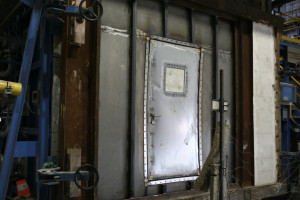Ground-breaking Door Safety Test
InterDam has successfully conducted a ground-breaking door safety test. Between July and September, 2016, the company’s engineers subjected their G21 Fire Door to a single sample blast and fire test. The result was successful. “We have now confirmed that our standard G21 Fire Door can withstand a 0.56 bar blast followed by an A60 rated fire, while remaining structurally sound,” says Managing Director Berend Groeneveld.
The company has performed similar successful tests on walls at their customers’ request. But this is the first time a company has proactively subjected doors to this type of testing, with a Lloyds Register Surveyor on hand to certify that the tests were performed on a single sample. “A blast event is quite often followed by a fire,” explains Mr Groeneveld. “But this blast can compromise the door’s ability to protect against this fire. And we were amazed to discover that there are no formal regulations in place for the certification of doors under these conditions.”
The blast test was conducted at the TNO blast testing facilities in Rijswijk, the Netherlands. “Post-blast, the door was intact and fully operational,” says R&D Director Paul Goudswaard. “It didn’t detach or crack, and there was no damage to the hinges, vision panel, latches or door handle. It remained a Category One explosion-resistant door. During the subsequent fire test, we exposed the door to temperatures up to almost 1000ºC for over an hour, and it met or exceeded all safety parameters.” The final test results can now be used to calibrate the Final Element Models (FEMs) to approve alternative parameters for higher and lower blasts and project-specific door dimensions.
“We want to introduce this type of testing and quality as an industry best practice with the hope that it will lead to new regulatory norms,” says Mr Groeneveld. “Our ultimate goal is to keep staff and equipment safe in hazardous environments.”







